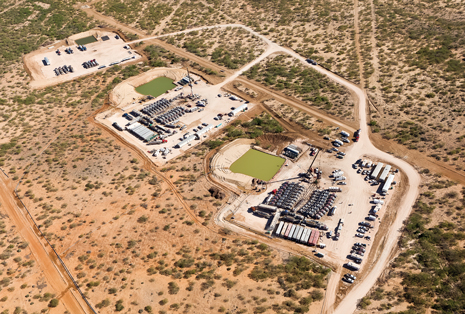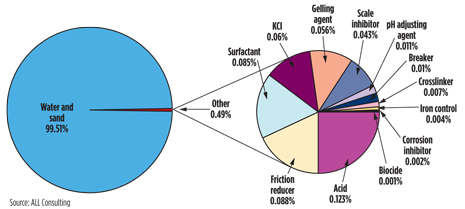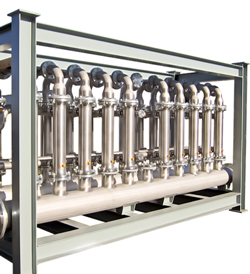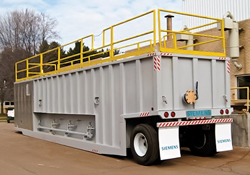RUSSELL WRIGHT, Contributing Editor
 |
| Fracturing spread on an SM Energy well site near Cibolo, Texas, where Sanjel fracing crews used recycled water. |
|
Hydraulic fracturing has been a significant part of part of oil and gas development for nearly 60 years. An estimated 35,000 wells have been hydraulically fractured annually in the U.S., with some one million wells having received the treatment since its first implementation, according to the American Petroleum Institute. With production from unconventional oil and gas fields escalating, hydraulic fracturing will continue to rise, as will the need for water. The management of water resources—including acquisition, use, treatment and disposal—is increasingly a significant facet of shale oil and gas development.
WATER MANAGEMENT
Several critical steps should be taken to ensure that water resources are handled properly, including:
Operators should communicate proactively with local water planning and regulating agencies.
Planning on a basin-wide basis should anticipate the volumes of water required for fracturing, plus other water requirements for exploration and production operations.
A hierarchy of potential sources should be developed, based upon local conditions, with priority assigned to using wastewater from other industrial facilities.
Water supplies obtained from surface sources should consider the impact on sensitive watersheds, historical droughts, irrigation, and other community and industrial needs, and low-flow periods during the year.
Water from groundwater sources should be non-potable, where possible.
Operators should implement best-practice waste management, disposal and reuse for fluids within their drilling, fracturing and production operations.
If wastewater transportation is required, operators should developing a plan to mitigate impacts, such as wear on road infrastructures, and negative effects on area residents, while also enhancing safety.
The use of additives should be minimized, and where feasible, more environmentally benign additives should be employed.
WATER SOURCING
Water requirements for fracturing vary greatly, depending on the specific shale play and even well location. Typically, 2-4 million gal. are needed for fracturing deep, unconventional shale formations, as water and sand are the biggest components, Fig. 1. The water may come from one or more of several sources, including surface bodies, municipal water supplies, groundwater, wastewater, or from water recycled from previous fracturing operations.
 |
| Fig. 1. Typical fracture fluid composition for hydraulic fracturing. |
|
Diverse sources. Chesapeake Energy, a leading shale operator, utilizes several sources of water in the Barnett, including municipalities, regional water districts, river authorities, ponds, lakes and groundwater wells. The operator is also reviewing the use of a variety of other water resources, such as discharge water from industrial or city wastewater treatment plants, power plant cooling water, marginal (saline) groundwater and reuse of hydraulic fracturing water.
Chesapeake works directly with local officials to arrange water purchases from a municipality when drilling inside city limits. Water is typically transported by temporary pipelines to drilling locations for storage in tanks or impoundments prior to use. Chesapeake also uses trucks to transport water supplies. Due to the diverse geographic area overlying the Barnett shale, the overall mix of water sources used depends on the region and the availability of sources near drilling sites.
Permitting. Regardless of the source, water used in Chesapeake’s drilling and fracturing process is purchased and, as required, properly permitted. This permitting ensures that water used for drilling and fracturing does not interfere with the available supply for other users. The company works closely with entities, such as the U.S. Army Corps of Engineers, Texas Commission on Environmental Quality, Texas Water Development Board, and a multitude of area groundwater conservation districts, regional river authorities, regional water districts and local municipalities on its proposed water use.
Operator strategies. After a severe drought in Texas during 2011, a new regulation was implemented in February 2012 that required Texas operators to report (to www.fracfocus.org) the amount of water used to frac each well. At the same time, groundwater conservation districts, municipal entities, and numerous river basin authorities began exacting more control over the use of water. As a consequence, operators are employing several different strategies to source water:
- Pioneer Natural Resources is tapping water from non-drinkable aquifers to develop acreage in the Permian basin.
- Breitling Oil & Gas trucked over three million gallons of water to a drill site 50 mi away, saying transportation costs were a small part of the well’s $3.5-million frac cost.
- Sewer effluent from nearby towns is being used by some companies for fracturing.
- For the Eagle Ford shale, Corpus Christi’s Water Department is seeking permission to lease water from Lake Corpus Christi to operators.
Operators are beginning to use portable field processing plants to recycle water. For example, Newfield Exploration recycles more than 80% of the water used in its Granite Wash operations. By sharing facilities with Chesapeake Energy, Linn Energy, Plains E&P and Cordillera Energy, Newfield plans to expand this model into the Eagle Ford and Anadarko Woodford fields.
Devon Energy has used a mobile distillation system approved by the Texas Railroad Commission to supply recycled water in fracturing certain wells.
Water sourcing services. Several service companies offer comprehensive water sourcing, treatment and disposal services. For example, Select Energy offers Waterone service, which includes a service line established to support operators in identifying, acquiring and permitting source water. Extensive water supplies are readily available through a portfolio of contracts with regulatory bodies, corporations and individuals. The company has access to over 400 MMbbl of water in the U.S. Capabilities include identification and assessment of source water, delivery, evaluation and planning, regulatory and permitting, environmental assessments, mapping and geographic information systems (GIS) support, and complete field water strategy, development and execution.
The Select Water Transfer service line specializes in high-volume, high-rate water transfer through a variety of mobile piping systems, including environmentally safe, no-leak pipe systems to support hydraulic fracturing. This includes more than 930 mi of overland transfer pipe and 1,200 water transfer pumps. Other equipment includes portable distribution manifolds on wheels, frac tank floats, fully hydraulic road crossings and rentals, such as light plants, trash trailers, tents, etc.
REGULATORY REQUIREMENTS
In the U.S., frac water management is governed at the national level by the Clean Water Act (SWA) and Safe Drinking Water Act (SDWA). The SDWA authorized EPA to regulate injection wells to protect underground sources of drinking water. The U.S. Congress amended the SDWA in 2005, to exclude hydraulic fracturing from coverage under the underwater injection control (UIC) program. Nevertheless, a number of U.S. federal laws still impact water management and disposal, including the National Pollutant Discharge Elimination System (NPDES) permit program, as well as a requirement for tracking any toxic chemicals used in fracturing fluids.
States with extensive shale activity have imposed strict regulations governing shale drilling production operations, such as depth of well casing to prevent aquifer contamination, disclosure of frac fluid content, and management of wastewater from flowback and produced water. States, such as Arkansas and Ohio, have placed local moratoriums on disposal wells in locations because of local seismic activity. In June 2013, the Illinois state government opened opportunities for operators to explore the New Albany shale play by what it termed the strictest regulations for fracturing and water management. Operators will be required to disclose chemicals and to test water, before and after, drilling as well as assume liability for any contamination.
As a prelude to possible legislation at the national level, the EPA has undertaken a major national study to understand the impact of hydraulic fracturing on drinking water resources. While the final report is due in 2014, a draft report released in 2011 linked groundwater pollution in Pavilion, Wyoming. However, in mid-June 2013, the EPA backed off from finalizing the Wyoming report, and instead, has asked Wyoming authorities to continue the investigation.
MANAGING FRAC WATER DISPOSAL
Regulations in most shale plays require that all fluids, including frac fluids and flowback water, must be removed from the well site. This water normally is:
- Injected into permitted disposal wells
- Delivered to water treatment facilities
- Reused/recycled.
These options depend upon the availability of suitable injection zones and the possibility of obtaining permits for injection into these zones; the capacity of commercial and/or municipal water treatment facilities; and the ability of either operators or such plants to successfully obtain surface water discharge permits. Requirements associated with these options will continue to become more stringent.
Injection wells. Injection wells for disposal of brine associated with oil and gas are classified as Class IID in EPA’s UIC program, and require state and federal permits. Disposal of flowback fluids through injection is widely recognized as being environmentally sound, well-regulated and proven effective. But to handle the amount of water associated with large-scale developments, additional injection wells in an area may be required
Municipal waste treatment facilities. The availability of municipal or commercial treatment plants may be limited to larger urban areas, where treatment facilities with sufficient capacity already exist. As with underground injection, transportation to treatment facilities might not be practical. Municipal sewage treatment facilities must have a state-approved pretreatment program for accepting any industrial waste. These plants must notify appropriate regulatory authorities of any new industrial waste that they plan to receive and certify that their facility is capable of treating the pollutants.
Industrial waste treatment facilities. Future disposal needs are not likely to be met by municipal facilities, because of regulatory restrictions and processing volume limitations. Thus, an alternative solution may be to construct private or industry-owned treating facilities. These may be built and operated by an industry cooperative, or by an environmental services company. In several regions, temporary treatment facilities are being set up in active drilling and development areas, or mobile facilities are used to treat the waste stream onsite. Temporary facilities can eliminate or reduce the trucking of waste streams, when they include temporary pipeline systems that serve local wells.
FIELD TREATMENT
The treatment of flowback and produced water decreases costs, while expanding water sources and supporting an environmentally sustainable water cycle. This option is exercised, when injection wells are not available, and in arid areas, where freshwater volumes are limited.
Flowback water typically contain TSS (total suspended solids) and TDS (total dissolved solids). High levels of TSS can obstruct pumping equipment and clog pore spaces in the wellbore High levels of salinity, due to TDS, can diminish the effectiveness of friction reducers and cause adverse precipitation. Also of concern are scale-forming contaminants, such as barium, calcium, and magnesium salts, and microbial growth that can plug pore spaces.
A simple reuse strategy that many operators employ is to remove TSS through filters and then add sufficient fresh water to reduce the salt content to the required amount. Removal of TDS can be more complex, including treatment processes, such as membrane reverse osmosis, evaporation and thermal distillation.
TREATMENT TECHNOLOGIES
Several service companies offer technologies to treat flowback and produced water through the removal of TSS and TDS contaminants. A few examples of treatment technologies are presented here.
Veolia Water Solutions. Technologies developed by Veolia Water Solutions and Technology (VWS) focus on waste reduction, water recycling and reuse, and ZLD (zero liquid discharge). Each solution is designed for specific water chemistry and production objectives. For primary and secondary oil removal, the firm’s AutoFlot Induced Gas Flotation process removes free oil (<20mg/l), while utilizing a low retention time (5 min.). Its biological treatment for BOD/VOC removal, AnoxKaldnes, involves a moving bed bio-reactor (MBBR). This provides high specific surface area for biofilm growth with good sludge settling characteristics. No backwashing is required, and its compact, flexible design allows easy retrofit
Primary hardness/TSS removal is obtained through Veolia’s Multiflo chemical softening process. This is a high-rate softening process that results in high-quality effluent (TH<20, Turb<10). Packaged plants up to 1,200 gpm are available, and mobile units may be used for on-site testing. Evaporation and crystallization systems from VWS thermally treat flowback and produced water with greater than 95% water recovery. With this ZLD system, little, if any, pretreatment is required for high TDS wastewater, and the only waste is solid saltcake.
The use of the company’s Opus technology provides high system recovery (90+%, depending on TDS). Advantages claimed include lower costs, infrequent cleaning intervals, effective fouling and scaling control, adaptability to variations in feed water and high salt rejection. Power Clean ORF provides free oil removal (<2.0 mg/l) and 95% removal efficiency. In OPUS II technology, the pre-treatment consists of chemical softening, followed by free oil and solids removal using CeraMem ultrafiltraion technology, Fig. 2.
 |
| Fig. 2. Chesapeake Energy Factsheet, May 2012. |
|
For example, flowback and produced water from a Marcellus shale well was effectively treated utilizing evaporation and crystallization technology for both low- and high-TDS wastewater. The process efficiently removed sodium and calcium chlorides, as well as heavy metals commonly found in effluent generated from produced water. Based on the wastewater composition from this region, the process eliminated the need for expensive pre-treatment of produced water, thus reducing capital and operating costs. The ZLD system provided greater than 95% water recovery, with the only waste being a solid saltcake suitable for landfill disposal.
Select Energy Services. In 2012, Select Energy Services signed a strategic alliance agreement with Water Rescue Holdings, a Texas-based provider of water treatment and reuse technology, providing access to versatile and mobile water treatment, and recycling technology, through Water Rescue’s electrocoagulation units. Select also acquired a water delivery pipeline that delivers water effluent from a paper mill for reuse by operators in northern Louisiana for hydraulic fracturing and other applications.
Select’s Fluidity service is offered as an all-inclusive, customized solution for water sourcing, transfer, containment, treatment, reuse, recycling, transport, disposal and infrastructure-related development. Select’s water treatment capabilities include bag filters, reverse osmosis, hydrocylone, rotary fan dryers, sand filters and shaker tables. Also offered are chemical precipitation and electrocoagulation technologies that tie flowback and produced water into frac supply, completing the reuse cycle.
Electrocoagulation is used to kill bacteria, remove heavy metals and solids, and thus, reduce hardness. This process can treat water volumes ranging from 1,600 to 4,800 gpm. The process averages 95% efficiency, meaning for every 100 trucks needed for disposal, only five require post-treatment. It also reduces the need for new freshwater sources and lessens the amount of wastewater injected into disposal wells
Chemical precipitation technology treats and recovers Class II UIC waste and recycles 99.5% with 0.5% solid, non-hazardous waste that can be dewatered. The effluent is 2% KCI/NaCL water. The disposal service line is equipped with permitted disposal facilities strategically positioned throughout major U.S. shale plays, with over 100,000-bpd disposal capacity. Disposal facilities are available for saltwater and incidental non-hazardous oil and gas waste disposal.
Sanjel. In the Bakken and Eagle Ford shales, Sanjel is preparing frac fluid water from both recycled produced water and frac water. Citing the company’s “robust chemistry,” Kim Day, manager of Corporate Applications and Implementation, says the company must deal with constantly changing water properties, even within the same field. Their recent investment in a team of chemists, as well as specialized instruments and analytical tools, is helping increase the quality of the treated water. When designing frac jobs, some frac fluids have been reformulated in less than 24 hr. Up to 50 stages have been fractured in a single well, with the average number of stages running from 20 to 30.
Sanjel has also developed a chemical hazard rating system. It is based on the Globally Harmonized System of Classification and Labeling of Chemicals (GHS). During 2012, the company has used this as a guideline to make its chemicals exponentially greener. For example, a recent blend for acid jobs in the Eagle Ford region saw its Sanjel Chemical Hazard Rating System (SCHRS) score drop from 34 to 17.
Siemens. A new wastewater treatment system from Siemens aims to streamline the way in which frac water is recycled by reducing the net amount of waste and by making the process more efficient. A central unit has been installed to treat nearly 300,000 gwpd from Marcellus shale drilling and other local operating wells. Siemens also plans to bring the water treatment units directly to well sites, thereby eliminating costs associated with transporting water to and from a treatment facility, Fig. 3.
 |
| Fig. 3. Dlouhy, Jennifer, Mysanantonio.com, May 28, 2012. |
|
The plant processes more than 130,000 gwpd, which reduces to about 36,000 gallons of sludge, with the remaining solids from that mixture separated into chalky cakes. Water entering is scanned by radiation detectors for any radioactive or hazardous materials. In the lab, a small sample is checked for suspended solid concentration, pH level, etc.
Using Siemens’ technology, a reaction tank chemically treats the water by adjusting pH and adding reactants that cause the undissolved particles to clump. This process separates the mixture into a clear component atop a thick layer of sludge. Accumulated sludge is periodically pumped out as suspended solids settle out. The remaining, thicker liquid mixture goes through filter presses that eliminate most of the moisture, while producing lime-coated filter cakes. Those cakes are placed in landfills. After retesting, the water is discharged to the local sanitation authority. The final product has a high salinity content, around 40%, compared to 3% for seawater, but otherwise, it is clean enough to drink.
EcoSphere Technologies. For arid regions, such as Texas’ Eagle Ford play and in Utah, energy producers are increasingly turning to recycling water. The reuse of water in multiple wells decreases the need to pull fresh water out of the drinking supply. Newfield Exploration, for example, has hired two companies to treat wastewater from its hydraulic fracturing operations.
Florida-based EcoSphere Technologies, is using electrochemistry to destroy microorganisms in water produced from Newfield's wells. Mobile equipment creates ozone by passing oxygen across an electric field, and the resulting ozone then is converted into hydroxyl radicals that decompose contaminants.
Environmentally Clean Systems. In the Uinta basin, Newfield contractor, Environmentally Clean Systems, treats water in a plant. The electrocoagulation process involves passing water through tanks containing electrified plates to form ions that attach themselves to contaminants, making larger bundles that can be screened out.
INTERNATIONAL DEVELOPMENTS
While North America has led the development of shale oil and gas resources, early efforts are underway throughout the world, including Poland, China, Argentina and South Africa. Concerns over fracturing and water use have emerged in these and other regions, leading even to a moratorium in France and significant restrictions in England.
In Poland, water use is governed by the Ministry of Environment, State Mining Authority and National Water Management Authority. The Ministry of Environment issues authorizations for shale activities with input from the Department of Geology and Geological Concessions (DGGC). A separate water permit is required for utilizing surface and ground water. In addition, the National Water Management Authority issues permits covering wastewater discharge. In Argentina’s Neuquén province, the General Water Resource Office (DGRH) is responsible for regulating water use. A user community has been established to resolve potential conflicts in water usage among oilfield, agricultural and public sectors. In March 2012, China’s Ministry of Environmental Protection (MEP) issued guidelines for oil and gas industry pollution prevention, which provided guidance on the use of fracing fluids, wastewater recycling and underground water monitoring.
COMPARATIVE WATER USE
Water is an essential component of shale gas development, but the volume of water necessary to drill and fracture the wells represents a very small percentage of the total water resources used in the particular geographic area. Due to concerns over water resulting from growing population, drought, and shale drilling and fracturing, the Texas Water Development Board (TWDB) conducted a study in 2006 of a 19-county area in North Texas that included the Barnett shale development area. This report revealed that the amount of water from all sources used for shale activity had been a relatively small (less than 1%), although growing, percentage of the total water use (450 billion gal). The largest water users were municipal/public water supply (82.5%), irrigation (6%), industry and mining (4.5%), power generation (4%) and livestock (2%). During the drilling and completion phases of each well, use of this water does not represent a long-term commitment, since its use is temporary, occurring only once.
Water and energy are interdependent, but water is essential to energy resource development. Conversely, energy resources are needed for producing, processing, distributing and using water resources. Assuming a typical Barnett deep shale gas well will produce approximately 2.65 Bcf over its lifetime, the amount of water used to produce the gas equates to about 1.47 gal for 1 MMbtu. To put this in perspective, this is less than 20% of the water needed to produce 1 MMbtu from a coal-fired power plant, or 0.05% of the water needed to produce the same energy equivalent of ethanol for fuel. Shale gas development, with its comparatively small water use per unit of energy, is making a positive energy and economic contribution at a relatively low cost to the overall water supply. 
REFERENCES
1. Water management associated with hydraulic fracturing, Upstream Segment, API Guidance Document HF2, First Edition, June 2010.
2. Chesapeake Energy Factsheet, May 2012.
3. Dlouhy, Jennifer, Mysanantonio.com, May 28, 2012.
4. Warlick, Don, “Water management 101: Frac water needs driving new alternatives for supply,” Oil & Gas Financial Journal, Aug. 6, 2012.
5. Accenture, “Water and shale development,” 2012.
|






